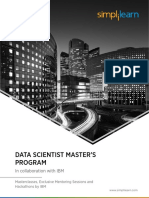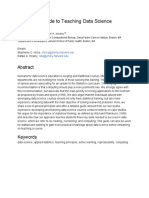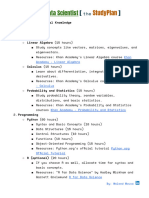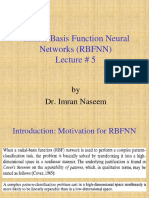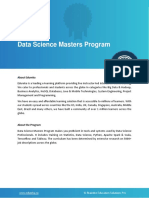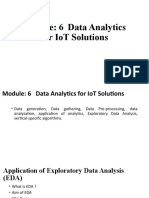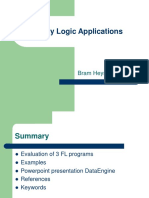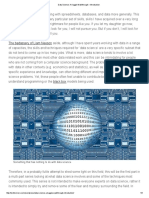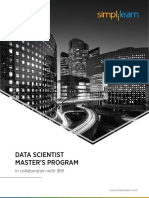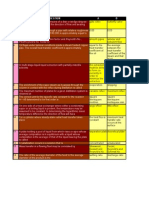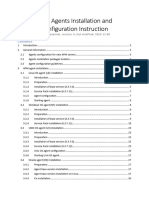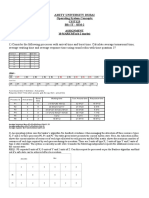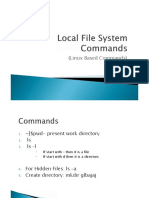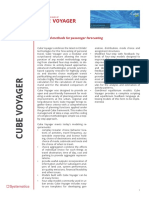DATA SCIENTIST
MASTER’S PROGRAM
In collaboration with IBM
www.simplilearn.com
1 | www.simplilearn.com
� Contents
03 About the Course
04 Key Features of Data Scientist Master’s Program
05 About IBM and Simplilearn collaboration
06 Learning Path Visualization
07 Program Outcomes
08 Who Should Enroll
09 Courses
Step 1: Data Science in Real life
09
Step 2: Statistics Essentials
10
Step 3: R Programming for Data Science
12
Step 4: Data Science with R
13
Step 5: Python for Data Science
15
Step 6: Data Science with Python
16
Step 7: Machine Learning
18
Step 8: Tableau
20
Step 9: Big Data Hadoop and Spark Developer
22
Step 10: Data Science Capstone Project
24
25 Electives
26 Certificates
27 Advisory Board Members
2 | www.simplilearn.com
�About the Course
This Data Scientist Master’s tools and technologies including
Program in collaboration with IBM R, SAS, Python, Tableau, Hadoop,
accelerates your career in Data and Spark. Become an expert in
Science providing you with world- Data Science by deep diving into
class training and skills required to the nuances of data interpretation,
become successful in this domain. interworking technologies like
The program offers extensive Machine Learning, and mastering
training on the most in-demand powerful programming skills to take
Data Science and Machine Learning your career in Data Science to the
skills with hands-on exposure to key next level.
3 | www.simplilearn.com
�Key Industry recognized
certifications from
Features Simplilearn and IBM
for this unique
collaboration
program
Portfolio worthy 15+ Real-life projects
capstone providing hands-on
demonstrating industry training
mastered
concepts
30+ In-demand Lifetime access
skills to self-paced
learning and
class recordings
4 | www.simplilearn.com
�About IBM and Simplilearn
collaboration
A joint partnership with Simplilearn company, headquartered in Armonk,
and IBM introduces students to New York, offering a plethora of
an integrated blended learning, technology and consulting services.
making them an expert in Artificial Each year, IBM invests $6 billion in
Intelligence and Data Science. The research and development and has
program in collaboration with IBM achieved five Nobel Laureates, nine
will make students industry ready US National Medals of Technology,
for Artificial Intelligence and Data five US National Medals of Science,
Science job roles. IBM is a leading six Turing Awards, and 10 Inductees
cognitive solution and cloud platform in US Inventors Hall of Fame.
About Simplilearn
Simplilearn is a leader in digital skills by the industry’s highest completion
training, focused on the emerging rates. Partnering with professionals and
technologies that are transforming our companies, we identify their unique needs
world. Our blended learning approach and provide outcome-centric solutions to
drives learner engagement and backed help them achieve their professional goals.
5 | www.simplilearn.com
�Learning Path - Data Scientist
Electives
IBM Watson for Chatbots
Machine Learning with R
Data Science in
Real life
Statistics R Programming for
Essentials Data Science
Python for Data Science
Data Science with R
Data Science Machine
with Python Learning
Big Data Hadoop and Tableau
Spark Developer
Capstone
Project
6 | www.simplilearn.com
�Data Scientist Master’s Program Outcomes
Gain an in-depth understanding of Understand the different
data structure and data manipulation components of the Hadoop
ecosystem
Understand and use linear and
non-linear regression models and Learn to work with HBase, its
classification techniques for data architecture and data storage,
analysis learning the difference between
HBase and RDBMS, and use Hive and
Impala for partitioning
Obtain an in-depth understanding
of supervised and unsupervised
learning models such as linear Understand MapReduce and its
regression, logistic regression, characteristics, plus learn how to
clustering, dimensionality reduction, ingest data using Sqoop and Flume
K-NN and pipeline
Master the concepts
Perform scientific and technical recommendation engine, and time
computing using the SciPy package series modeling and gain practical
and its sub-packages such as mastery over principles, algorithms,
Integrate, Optimize, Statistics, IO, and applications of Machine Learning
and Weave
Learn to analyze data using Tableau
Gain expertise in mathematical and become proficient in building
computing using the NumPy and interactive dashboards
Scikit-Learn package
7 | www.simplilearn.com
�Who Should Enroll in this Program?
The Data Science role requires IT Professionals
an amalgam of experience, Data
Science knowledge, and using the Analytics Managers
correct tools and technologies.
It is a solid career choice for Business Analysts
both new and experienced Banking and Finance
professionals. Aspiring Professionals
professionals of any educational
background with an analytical Marketing Managers
frame of mind are most suited to
pursue the Data Scientist Master’s Supply Chain Network
Program, including: Managers
Beginners or Recent Graduates
in Bachelors or Masters Degree
8 | www.simplilearn.com
� S
T
E
Data Science in Real life P
1
Data Science is the highly sought field of the century. Explore the truth 2
about what Data Science is and hear from real practitioners telling real
stories about what it means to work in Data Science and use cases for the 3
same.
4
5
Key Learning Objectives
6
Gain fundamental knowledge of what is Data Science and what do
Data Science people do 7
Learn about Data Science in a business context and what is the future
of Data Science
8
Understand Data Science applications and discover some use cases
9
for Data Science
10
Course curriculum
Lesson 1 - Defining Data Science
Lesson 2 - What Does a Data Science Professional Do?
Lesson 3 - Data Science in Business
Lesson 4 - Use Cases for Data Science
Lesson 5 - Data Science People
9 | www.simplilearn.com
� S
T
E
Statistics Essentials P
1
Statistics is the science of assigning a probability to an event based 2
on experiments. It is the application of quantitative principles to
the collection, analysis, and presentation of numerical data. Ace the 3
fundamentals of Data Science, statistics, and Machine Learning with this
course. It will enable you to define statistics and essential terms related to
4
it, explain measures of central tendency and dispersion, and comprehend 5
skewness, correlation, regression, distribution. You will be able to make
data-driven predictions through statistical inference. 6
7
Key Learning Objectives 8
Understand the fundamentals of statistics 9
Work with different types of data
10
How to plot different types of data
Calculate the measures of central tendency, asymmetry, and variability
Calculate correlation and covariance
Distinguish and work with different types of distribution
Estimate confidence intervals
Perform hypothesis testing
Make data-driven decisions
Understand the mechanics of regression analysis
Carry out regression analysis
Use and understand dummy variables
Understand the concepts needed for data science even with Python
and R!
10 | www.simplilearn.com
�Course curriculum
Lesson 1 - Introduction
Lesson 2 - Sample or population data?
Lesson 3 - The fundamentals of descriptive statistics
Lesson 4 - Measures of central tendency, asymmetry, and variability
Lesson 5 - Practical example: descriptive statistics
Lesson 6 - Distributions
Lesson 7 - Estimators and estimates
Lesson 8 - Confidence intervals: advanced topics
Lesson 9 - Practical example: inferential statistics
Lesson 10 - Hypothesis testing: Introduction
Lesson 11 - Hypothesis testing: Let’s start testing!
Lesson 12 - Practical example: hypothesis testing
Lesson 13 - The fundamentals of regression analysis
Lesson 14 - Subtleties of regression analysis
Lesson 15 - Assumptions for linear regression analysis
Lesson 16 - Dealing with categorical data
Lesson 17 - Practical example: regression analysis
11 | www.simplilearn.com
� S
T
E
R Programming for Data Science P
1
Gain insight into the R Programming language with this introductory 2
course. An essential programming language for data analysis, R
Programming is a fundamental key to becoming a successful Data 3
Science professional. In this course you will learn how to write R code,
learn about R’s data structures, and create your own functions. After the
4
completion of this course, you will be fully able to begin your first data 5
analysis.
6
Key Learning Objectives 7
Learn about math, variables, and strings, vectors, factors, and vector 8
operations
9
Gain fundamental knowledge on arrays and matrices, lists, and data
frames 10
Get understanding on conditions and loops, functions in R, objects,
classes, and debugging
Learn how to accurately read text, CSV and Excel files plus how to
write and save data objects in R to a file
Understand and work on strings and dates in R
Course curriculum
Lesson 1 - R basics
Lesson 2 - Data structures in R
Lesson 3 - R Programming fundamentals
Lesson 4 - Working with Data in R
Lesson 5 - Stings and Dates in R
12 | www.simplilearn.com
� S
T
E
Data Science with R P
1
The next step to a data scientist is learning R - the upcoming and most 2
in-demand open source technology. R is an extremely powerful Data
Science and analytics language which has a steep learning curve and a 3
very vibrant community. This is why it is quickly becoming the technology
of choice for organizations who are adopting the power of analytics for
4
competitive advantage. 5
6
Key Learning Objectives
7
Gain a foundational understanding of business analytics
8
Install R, R-studio, and workspace setup, and learn about the various R
packages. 9
Master R programming and understand how various statements are 10
executed in R.
Gain an in-depth understanding of data structure used in R and learn
to import/export data in R.
Define, understand and use the various apply functions and DPYR
functions.
Understand and use the various graphics in R for data visualization.
Gain a basic understanding of various statistical concepts.
Understand and use hypothesis testing method to drive business
decisions.
Understand and use linear, non-linear regression models, and
classification techniques for data analysis.
Learn and use the various association rules and Apriori algorithm.
Learn and use clustering methods including K-means, DBSCAN, and
hierarchical clustering.
13 | www.simplilearn.com
�Course curriculum
Lesson 1: Introduction to Business Analytics
Lesson 2 - Introduction to R Programming
Lesson 3 - Data Structures
Lesson 4 - Data Visualization
Lesson 5 - Statistics for Data Science-I
Lesson 6 - Statistics for Data Science-II
Lesson 7 - Regression Analysis
Lesson 8 - Classification
Lesson 9 - Clustering
Lesson 10 - Association
14 | www.simplilearn.com
� S
T
E
Python for Data Science P
1
Kickstart your learning of Python for Data Science with this introductory 2
course and familiarize yourself with programming. Carefully crafted by
IBM, upon completion of this course you will be able to write your Python 3
scripts, perform fundamental hands-on data analysis using the Jupyter-
based lab environment, and create your own Data Science projects using 4
IBM Watson.
5
6
Key Learning Objectives
7
Write your first Python program by implementing concepts of
variables, strings, functions, loops, conditions 8
Understand the nuances of lists, sets, dictionaries, conditions and 9
branching, objects and classes
Work with data in Python such as reading and writing files, loading,
10
working, and saving data with Pandas
Course curriculum
Lesson 1 - Python Basics
Lesson 2 - Python Data Structures
Lesson 3 - Python Programming Fundamentals
Lesson 4 - Working with Data in Python
Lesson 5 - Working with NumPy arrays
15 | www.simplilearn.com
� S
T
E
Data Science with Python P
1
This Data Science with Python course will establish your mastery of 2
Data Science and analytics techniques using Python. With this Python
for Data Science Course, you’ll learn the essential concepts of Python 3
programming and gain in-depth knowledge in data analytics, Machine
Learning, data visualization, web scraping, and natural language 4
processing. Python is a required skill for many Data Science positions, so
jump start your career with this interactive, hands-on course.
5
6
Key Learning Objectives 7
Gain an in-depth understanding of Data Science processes, data 8
wrangling, data exploration, data visualization, hypothesis building,
and testing. You will also learn the basics of statistics 9
Install the required Python environment and other auxiliary tools and 10
libraries
Understand the essential concepts of Python programming such as
data types, tuples, lists, dicts, basic operators and functions
Perform high-level mathematical computing using the NumPy package
and its vast library of mathematical functions
Perform scientific and technical computing using the SciPy package
and its sub-packages such as Integrate, Optimize, Statistics, IO, and
Weave
Perform data analysis and manipulation using data structures and
tools provided in the Pandas package
Gain expertise in Machine Learning using the Scikit-Learn package
Gain an in-depth understanding of supervised learning and
unsupervised learning models such as linear regression, logistic
regression, clustering, dimensionality reduction, K-NN and pipeline
16 | www.simplilearn.com
� Use the Scikit-Learn package for natural language processing
Use the matplotlib library of Python for data visualization
Extract useful data from websites by performing web scraping using
Python
Integrate Python with Hadoop, Spark, and MapReduce
Course curriculum
Lesson 1 - Data Science Overview
Lesson 2: Data Analytics Overview
Lesson 3: Statistical Analysis and Business Applications
Lesson 4: Python Environment Setup and Essentials
Lesson 5: Mathematical Computing with Python (NumPy)
Lesson 6 - Scientific computing with Python (Scipy)
Lesson 7 - Data Manipulation with Pandas
Lesson 8 - Machine Learning with Scikit–Learn
Lesson 9 - Natural Language Processing with Scikit Learn
Lesson 10 - Data Visualization in Python using matplotlib
This lesson teaches you to visualize data in python using matplotlib
and plot them.
Lesson 11 - Web Scraping with BeautifulSoup
Lesson 12 - Python integration with Hadoop MapReduce and Spark
17 | www.simplilearn.com
� S
T
E
Machine Learning P
1
Simplilearn’s Machine Learning course will make you an expert in Machine 2
Learning, a form of Artificial Intelligence that automates data analysis to
enable computers to learn and adapt through experience to do specific 3
tasks without explicit programming. You will master Machine Learning
concepts and techniques, including supervised and unsupervised learning, 4
mathematical and heuristic aspects, and hands-on modeling to develop
algorithms and prepare you for your role with advanced Machine Learning
5
knowledge. 6
7
Key Learning Objectives
8
Master the concepts of supervised and unsupervised learning,
recommendation engine, and time series modeling 9
Gain practical mastery over principles, algorithms, and applications of 10
Machine Learning through a hands-on approach that includes working
on four major end-to-end projects and 25+ hands-on exercises
Acquire thorough knowledge of the statistical and heuristic aspects of
Machine Learning
Implement models such as support vector machines, kernel SVM,
naive Bayes, decision tree classifier, random forest classifier, logistic
regression, K-means clustering and more in Python
Validate Machine Learning models and decode various accuracy
metrics. Improve the final models using another set of optimization
algorithms, which include Boosting & Bagging techniques
Comprehend the theoretical concepts and how they relate to the
practical aspects of Machine Learning
18 | www.simplilearn.com
�Course curriculum
Lesson 1 - Introduction to Artificial Intelligence and Machine Learning
Lesson 2: Data Wrangling and Manipulation
Lesson 3: Supervised Learning
Lesson 4: Feature Engineering
Lesson 5: Supervised Learning-Classification
Lesson 6: Unsupervised learning
Lesson 7: Time Series Modelling
Lesson 8: Ensemble Learning
Lesson 9: Recommender Systems
Lesson 10: Text Mining
19 | www.simplilearn.com
� S
T
E
Tableau Desktop 10 P
1
This Tableau Desktop 10 training will help you master the various aspects 2
of the program and gain skills such as building visualization, organizing
data, and designing dashboards. You will also learn concepts of statistics, 3
mapping, and data connection. It is an essential asset to those wishing to
succeed in Data Science. 4
5
Key Learning Objectives 6
Grasp the concepts of Tableau Desktop 10, become proficient with
statistics and build interactive dashboards
7
Master data sources and datable blending, create data extracts and
8
organize and format data 9
Master arithmetic, logical, table and LOD calculations and ad-hoc
analytics 10
Become an expert on visualization techniques such as heat map, tree
map, waterfall, Pareto, Gantt chart and market basket analysis
Learn to analyze data using Tableau Desktop as well as clustering and
forecasting techniques
Gain command of mapping concepts such as custom geocoding and
radial selections
Master Special Field Types and Tableau Generated Fields and the
process of creating and using parameters
Learn how to build interactive dashboards, story interfaces and how to
share your work
20 | www.simplilearn.com
�Course curriculum
Lesson 1 - PGetting Started With Tableau
Lesson 2 - Working With Tableau
Lesson 3 - Deep diving with Data and Connections
Lesson 4 - Creating Charts
Lesson 5 - Adding calculations to your workbook
Lesson 6 - Mapping data in Tableau
Lesson 7 - Dashboards and Stories
Lesson 8 - Visualizations For An Audience
21 | www.simplilearn.com
� S
T
E
Big Data Hadoop and Spark Developer P
1
Learn how to work Big Data and its components. Deep-dive into Hadoop 2
and its ecosystem including MapReduce, HDFS, Yarn, HBase, Impala,
Sqoop and Flume. This course provides an introduction to Apache Spark 3
which is a next step after Hadoop. After completing this course, you
will be able to successfully pass the Cloudera CCA175 certification but 4
embrace this technology as part of your role as a Data Scientist.
5
6
Key Learning Objectives
7
Master the concepts of the Hadoop framework and its deployment in
a cluster environment 8
Understand how the Hadoop ecosystem fits in with the data 9
processing lifecycle
Learn to write complex MapReduce programs
10
Describe how to ingest data using Sqoop and Flume
Get introduced to Apache Spark and its components
List the best practices for data storage
Explain how to model structured data as tables with Impala and Hive
Course curriculum
Lesson 1 - Introduction to Big Data and Hadoop Ecosystem
Lesson 2 - HDFS and Hadoop Architecture
Lesson 3 - MapReduce and Sqoop
Lesson 4 - Basics of Impala and Hive
Lesson 5 - Working with Hive and Impala
Lesson 6 - Type of Data Formats
22 | www.simplilearn.com
� Lesson 7 - Advanced HIVE concept and Data File Partitioning
Lesson 8 - Apache Flume and HBase
Lesson 9 - Apache Pig
Lesson 10 - Basics of Apache Spark
Lesson 11 - RDDs in Spark
Lesson 12 - Implementation of Spark Applications
Lesson 13 - Spark Parallel Processing
Lesson 14 - Spark RDD Optimization Techniques
Lesson 15 - Spark Algorithm
Lesson 16 - Spark SQL
23 | www.simplilearn.com
� S
T
E
Data Science Capstone Project P
1
This Data Science Capstone project will give you an opportunity to 2
implement the skills you learned throughout this Program. Through
dedicated mentoring sessions, you’ll learn how to solve a real-world, 3
industry-aligned Data Science problem, from data processing and model
building to reporting your business results and insights. The project is 4
the final step in the learning path and will enable you to showcase your
expertise in Data Science to future employers.
5
6
Key Learning Objectives 7
Simplilearn’s online Data Science Capstone course will bring you through 8
the Data Science decision cycle, including data processing, building a
model and representing results. The project milestones are as follows: 9
10
Data Processing - In this step, you will apply various data processing
techniques to make raw data meaningful.
Model Building - You will leverage techniques such as regression and
decision trees to build Machine Learning models that enable accurate
and intelligent predictions. You may explore Python, R or SAS to build
your model. You will follow the complete model-building exercise
from data split to test and training and validating data using the k-fold
cross-validation process.
Model Fine-tuning - You will apply various techniques to improve the
accuracy of your model and select the champion model that provides
the best accuracy.
Dashboarding and Representing Results - As the last step, you will
be required to export your results into a dashboard with meaningful
insights using Tableau
24 | www.simplilearn.com
�Elective Course
IBM Watson for Chatbots:
This course provides a practical introduction on how to
build a chatbot with Watson Assistant without writing any
code and then deploy your chatbot to a real website in
less than five minutes. It will teach you to plan, build, test,
analyze, and deploy your first chatbot.
Machine Learning with R:
In this course, you will learn how to write R code, learn
about R’s data structures, and create your own functions.
With the knowledge gained, you will be ready to undertake
your first very own data analysis.You’ll further learn about
Supervised vs Unsupervised Learning, look into how
Statistical Modeling relates to Machine Learning, and do a
comparison of each using R.
25 | www.simplilearn.com
�Certificates
DATA SCIENTIST
Upon completion of this Master’s
Program, you will receive the
certificates from IBM and
Simplilearn in the Data Science
Has successfully graduated from the Data Engineer courses in the learning path. These
Masters Program summa cum laude having completed all mandated
course requirements and industry projects with distinction.
certificates will testify to your
Date: _ /_ /2019
skills as an expert in Data Science.
Upon program completion, you
will also receive an industry
recognized Master’s Certificate
from Simplilearn.
26 | www.simplilearn.com
�Advisory board member
Ronald Van Loon
Big Data Expert, Director Adversitement
Named by Onalytica as one of the 3 most
influential people in Big Data, Ronald is an
author for a number of leading Big Data and
Data Science websites, including Datafloq, Data
Science Central, and The Guardian. He is also a
renowned speaker at industry events.
27 | www.simplilearn.com
�USA
Simplilearn Americas, Inc.
201 Spear Street, Suite 1100, San Francisco, CA 94105
United States
Phone No: +1-844-532-7688
INDIA
Simplilearn Solutions Pvt Ltd.
# 53/1 C, Manoj Arcade, 24th Main, Harlkunte
2nd Sector, HSR Layout
Bangalore - 560102
Call us at: 1800-212-7688
www.simplilearn.com��
28 | www.simplilearn.com
